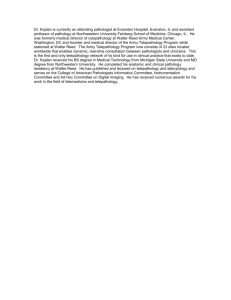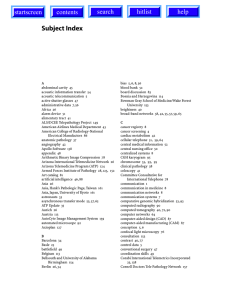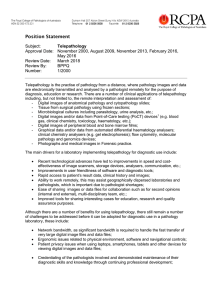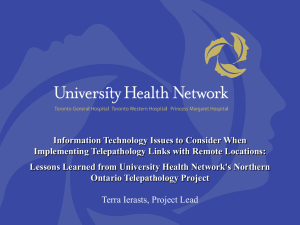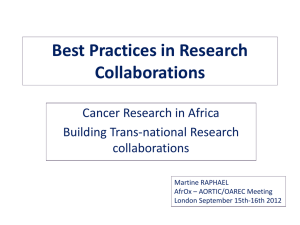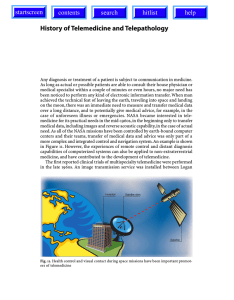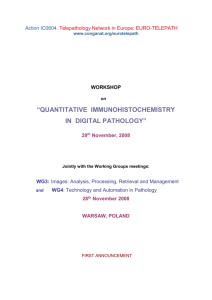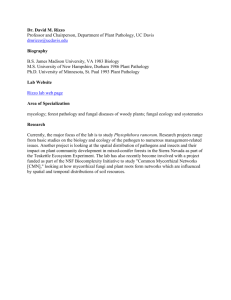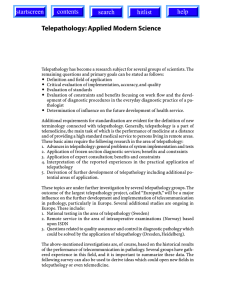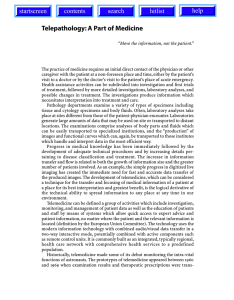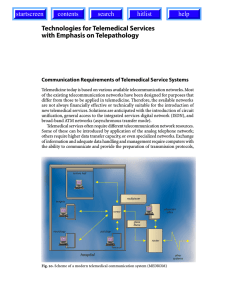Telepathology - Patologos de Puerto Rico
advertisement
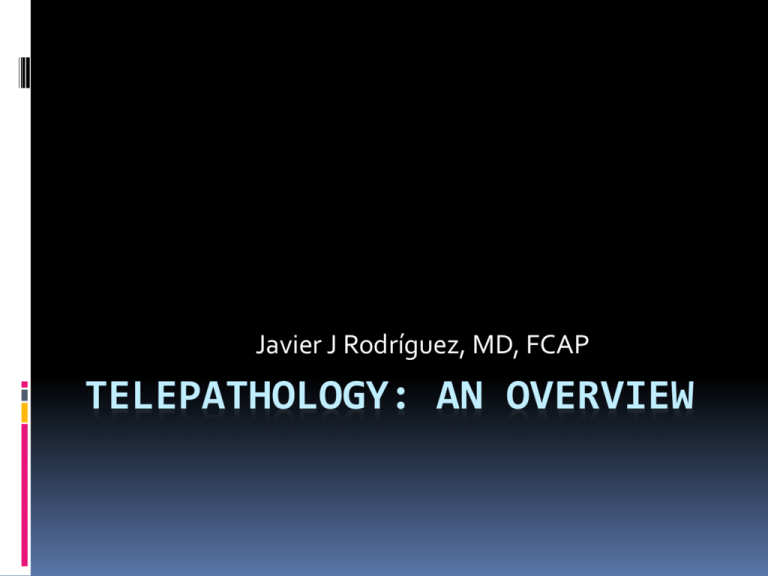
Javier J Rodríguez, MD, FCAP TELEPATHOLOGY: AN OVERVIEW “Telemedicine, and consequentially telepathology is not a science of the future but of the present and is here to stay, to the point that today‘s physicians are more and more required to have at least some knowledge of telemedicine.” Telepathology and Pathology at Distance: an Overview Dražen M. Jukiæ, Carlo B. Bifulco1 Let’s telepath… Some definitions and things to be familiar with How is a photomicrograph digital image created? A brief history Benefits Three different approaches to telepath Static images interchange Real Time Microscopy Virtual slides Some predictions… Some definitions Telemedicine: “Telemedicine is a method by which patients can be examined, investigated, monitored, and treated, with the patient and the doctor being located at different places” (Kumar S. Introduction to Telepathology. Telepathology, 2009) Telepathology: Branch of telemedicine that uses technology to transfer “image rich pathology data” between “remote locations” for diagnosis, education and research Some definitions: Digital Image Resolution: width x height. Pixel: “picture element”. The number of pixels comprising an image determines the “resolution of the image” Each pixel (dot) can be only one color. Each pixel storage information can be 8 bit, 12 bit, 16 bit, 24 bit at 32 bit (Color Depth) Determines the size of the file, not the projected resolution, or DPI It does not imply physical size. The greater the resolution the more data information available for the image Higher resolutions are useful for algorithmic analysis. Some definitions: DPI: Dots per inch. Better use the term Pixel per inch. Is a property of a printed or displayed image and is dependent on the physical size of the output. CCD: Charged Couple Device: The retina of the digital camera. An array of light sensitive elements (photosites) that produce voltage when exposed to light. It is an analogue device!!! Digital Camera resolutions: Total number of elements in the array. The higher the number of photosites the higher the resolution. Are photosites the actual physical representations of pixels? Some definitions: “ Resolution is also often quoted as the size of charged coupled device (CCD), which is effectively the number of pixels on the chip. It should be noted, however, that the size of the individual pixels varies amongst different types of CCDs. For microscopy, a pixel size (square) of 6.7 micrometers is thought to be ideal.” How is a digital image created? It’s an analogue world out there and somebody has to stop it!!! The conversion from analog to digital is equivalent to “ freezing real time instances” and assigning numbers to describe each frame: The Kodak moment!! The rest is a show of force of number crunching and manipulations How is a digital image created? A CCD imager consists of a large number of light-sensing elements arranged in a two-dimensional array on a thin silicon substrate. The light-sensing photodiode elements of the CCD respond to incident photons by absorbing much of their energy The photosites voltage are digitized to a value by the A/D converter: the CCD undergoes readout Values stored in the digital image specify the brightness and color of each pixel. The values of all photosites are stored and manipulated in the computer http://www.microscopyu.com/articles/digitalimaging/digitalintro.html A brief history Too brief of a history • Term coined in 1986 by Ronald Weinstein at Rush: • Weinstein RS. Prospects for telepathology. Hum Pathol 1986;17:433-4 Video conferencing dedicated digital/phone lines: “Telepathology is the practice of diagnostic pathology performed at a distance, with images viewed on a video monitor rather than directly through the (light) microscope”. 1990-2000: Internet era: Static images sharing-AFIP Current trend: whole slide virtualization Cons and Pros: Telepathology has proven useful for service to remote areas but it is still debatable how practical or cost effective it could be. The issue of developing countries costs vs expertise. Technology costs will make the accessibility of expertise more reachable. • Not necessarily a substitute for conventional diagnostic processes but an improvement and/or another tool for the pathologist. • Legal issues are still up in the air and often incompletely addressed • Benefits are really dependent on the type of technology used and the purpose: Static images, vs real time vs virtual slide Static Image Interchange: Exemplified by AFIP consultation service. Selected images of a case/slide are captured and transferred to consultant. Application: Education: classic diagnostic criteria Consultation: Emphasize interest areas Presentations and tumor boards Pathology reports content Image analysis: high resolution images. Static Image Interchange: Benefits: Fast image transfers with today internet speeds Low cost investment: Conventional microscope + Digital Camera: 5-10K Short time learning curve. Shortcomings Limited view of field Planes of focus are not captured Selection by non-expert may miss important areas. Adds cost to pathology reports content (debatable!!) Real Time Microscopy: Slide is shared in real time. Applications: Benefits: Long distance education Real time long distance consultation Frozen sections Wider field view Real time discussion Relatively low cost: 15-30K Relatively easy to sep up. Planes of focus may be addressed Shortcomings: Dependable on assisted operator (although new models use robotics) Requires higher than average upload bandwidth (expensive above T1 bandwidth) Dependable on line/internet condition. The higher the resolution, the more bandwidth it consumes. Requires special software for viewer/consultant end. Whole Slide Imaging The long waited technology: An digital image of the whole slide Eliminates all shortcomings of other modalities except cost Most renown vendors: Aperio and Bioimagene Applications: Anytime/anyplace long distance education. Anytime/anyplace long distance consultation. Presentations and tumor boards Image analysis: Immunohistochemistry analysis. More reproducible than human eye. Automation Slide archival Quality assurance Demo:http://www.uscap.org/ Whole Slide Imaging Shortcomings: Way expensive systems (>120K) Steep learning curve Large file size, >1gb/full slide (this can vary.) Slow to scan 2-8 minutes per slide depending on magnification Special software required Some predictions: Will pathologists follow the radiologists path? Argument 1: “ In most cases the goal of the radiologist is to give a differential diagnosis…for pathology the goal is a definitive diagnosis” John S Sinard, Practical Pathology Informatics Argument 2: Radiology sets of images not more than 200-500. Pathology sets of images >10 K Technology cost will go down but software will increase Speed will reach seconds for scanning Adoption will be slow given the high costs and the need to cost contain 10-20 years: adoption of a complete digital microscope.
